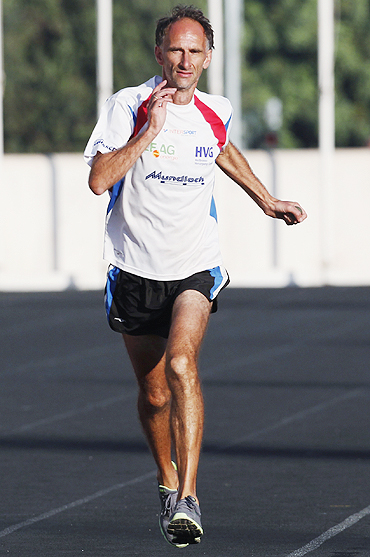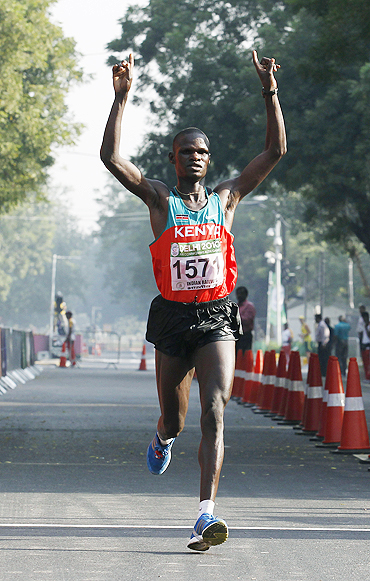Photographs: Reuters
Good news for marathoners as scientists have devised a new mathematical formula which could help them avoid "hitting the wall" and balance their energy and speed to complete the long-distance race.
Hitting the wall occurs when stored carbohydrates of runners are completely depleted, forcing their body to start burning fat. About 40 per cent of the runners generally suffer from this during marathons.
Now, researchers led by a Harvard medical student have worked out a mathematical model that calculates how much carbohydrate each individual runner needs to eat and how fast to run to avoid their body reserves running out and complete all the 26.2 miles (42km) of the race.
Quantification important for a competitive athlete
Image: Kenya's John Kelai celebrates after winning the men's marathon at the 2010 Commonwealth Games.Quantification is really important for a competitive athlete who wants to know, 'Can I run at a target pace of six minutes (a mile), or is that too fast, or do I have to go six minutes and 10 seconds per mile?' " lead researcher Benjamin Rapoport, a student of the Harvard-MIT Division of Health Sciences and Technology, told LiveScience.
"That difference can make the difference between hitting the wall and actually meeting your goal."
Rapoport, who himself a marathoner for years, knows what it's like to hit the wall and experienced the exhaustion and pain of running out of fuel.
"It feels a bit like you might feel if you're on a crash diet," Rapoport said. "Except that when you diet, it happens over the course of a few days, whereas a runner experiences it in the course of a few minutes."
VO2max is like the power output of a motor
Image: England's Michelle Cope runs past India Gate while competing in the women's marathon marathon at the Delhi Commonwealth GamesAccording to Rapoport, the ability to run long distances depends mainly on three factors: aerobic capacity, also known as VO2max; the energy cost of running, which is the equivalent to miles per gallon in an automobile; and the body's gas tank, the space available for storing carbohydrates.
The VO2max is like the power output of a motor. It's the maximum rate at which the muscles can take up oxygen to keep working, said Rapoport.
By combining these factors, Rapoport and his team created a mathematical model of how long and how fast runners of any size can go without hitting the wall. The model also helps define how much "carbo-loading", or carbohydrates consumption, the runner should complete in the days before the race.
Model reveals physiological basis to one of the biggest challenges
Image: Kenya's Robert Kiprono Cheruiyot crosses the finish line to win the Boston Marathon on April 19.The model, detailed in the journal PLoS Computational Biology, also reveals a physiological basis to one of the biggest challenges, the Boston Marathon.
To compete in the Boston Marathon, men aged 19 to 34 must have a qualifying time of three hours and 10 minutes or less, while the time for women of the same age is three hours and 40 minutes or less.
These numbers aren't based on science, Rapoport said, but rather set to weed out all but about the top 10 per cent of runners.
Model should help runners set a target pace
Image: Russia's Liliya Shobukhova (3rd from left) leads the pack during the final stages of the women's London marathon on April 25.The new model should help runners set a target pace and eat properly before the race, said Mark Cucuzzella, the Coach and Captain of Air Force Reserves Marathon Team.
"This takes basic science principles and puts them into something that's applicable for a recreational runner and a more advanced competitive runner," Cucuzzella said.
Rapoport himself plans to abide by the model when he runs the New York Marathon next month.
"Certainly I can say from personal experience, knowing this has helped me improve my own running," he said.






Comment
article